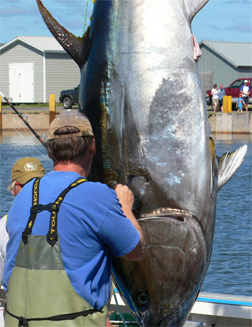Mediterranean bluefin tuna originate in the Gulf of Mexico
Jeremy Hance, mongabay.com
October 2, 2008
Newly discovered migration routes for critically-endangered bluefin tuna may impact their survival
Researchers have discovered a previously unknown migratory route for the northern bluefin tuna, proving for the first time that the species’ Mediterranean and North American subpopulations interact. According to the paper published in Science the two groups meet as juveniles then return to their birthplace to spawn. For a critically-endangered species that is still heavily fished, the new finding has large conservation and management implications.
Until now fisheries have assumed the bluefin populations of the Mediterranean and the North American coast were separate entities. However, the discovery of this new route shows that Mediterranean juvenile bluefins are being caught in substantial numbers by North American fisheries.
“We have learned that U.S. recreational fisheries focusing on small bluefin tuna are heavily subsidized by Mediterranean fish. North American commercial fisheries, on the other hand, depend exclusively on fish that are spawning in the Gulf of Mexico,” said Dr. David Secor from the University of Maryland Center for Environmental Science. “Juveniles are not conforming to the principal premise of how they’ve been managed — that fish keep to their own side of the Atlantic.”
 Giant Atlantic bluefin tuna from Prince Edward Island, Canada. Photo by Jay R. Rooker. |
This is the first study to show what biologists call ‘natal homing’ in a large, migratory fish. Natal homing is when an animal returns to its place of birth, often to reproduce. Sea turtles, salmon, and migratory birds display natal homing behaviors, while some whales are also believed to employ natal homing.
“Our study clearly shows that bluefin tuna possess remarkable natal homing abilities that rival those of Pacific salmon and migratory birds. Nearly all of the adults from both the Gulf of Mexico and Mediterranean Sea returned to their place of origin to spawn,” Dr. Jay Rooker said of Texas A&M Univesity.
This information comes at a time when bluefin tuna and the fisheries they support are in grave trouble. The species is critically-endangered, yet heavily fished both legally and illegally. The International Commission for the Conservation of Atlantic Tunas (ICCAT), charged with managing the bluefin populations, has come under increased criticism for failing to enact and enforce measures to save the species from extinction.
A recent independent review by international experts took ICCAT to account for mismanagement of bluefin tuna fisheries. The review called the management of bluefin tuna “an international disgrace” and called for an “immediate suspension” of bluefin fishing in the Eastern Atlantic and the Mediterranean. ICCAT meets next on November 17th in Morocco.
Secor says that this new understanding of northern bluefin tuna migrations “could be particularly troubling if North American juveniles head to the Mediterranean” because “high exploitation there might mean that few make it back”. Secor believes that the next step should be to determine where Mediterranean juveniles originate.
J.R. Rooker. Natal Homing and Connectivity in Atlantic Bluefin Tuna Populations. 3 OCTOBER 2008 VOL 322 SCIENCE














